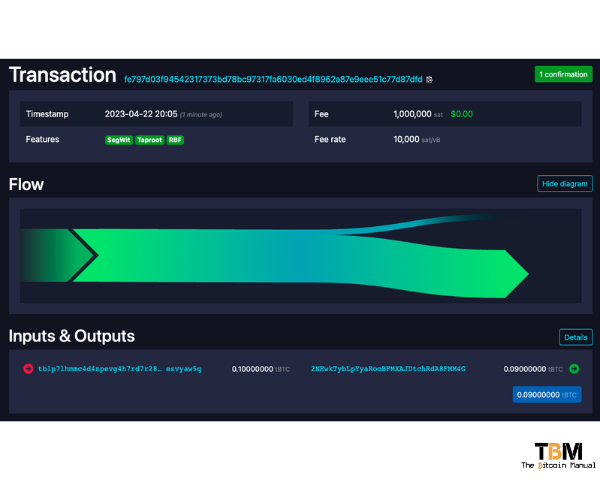A multi-sig wallet is a Bitcoin wallet that requires two or more signatures to confirm and send a transaction. It can be used by multiple keyholders or one user across multiple devices for distributed key signing. Multi-sig wallets provide an additional level of security and safety versus your traditional single sig since it doesn’t have that single point of failure.
In a single signature setup, it only takes you losing your keys or someone finding your keys to see your funds stolen or be lost forever. Multi-sig allows you to set up a failsafe, where you require more than one key to sign giving you more margin for ever.
For example, a 3-key wallet is a multi-sig wallet that is shared by three people or devices and requires a majority signatures to sign a transaction. As a result A 2 of the 3 keys assigned to that wallet multi-sig are required to sign a transaction.
You may also see “2 of 3” to indicate the number of copayers/co-signers needed to require a transaction to be broadcast to the mempool. If you’ve set-up a multi-sig where you hold all the keys, you’ll have no problem actioning a transaction, but if your keys are distributed, or you’re using a collaborative custody model it becomes more complex.
Bitcoin multi-signature solutions today require lots of time, coordination, and money in order to securely facilitate a transaction. While users gain a degree of security and privacy using standard multi-signature schemas, it can be a painful or rather MONSTEROUS task.
Coordinating a transaction with traditional communications mediums leaves you exposed, and is far from ideal, especially as these transactions become more commonplace. To ensure that the communication and co-ordination of multi-sig is secure, there needs to be secure ways of communicating with key holders.
Munster aims to enhance this process with recent Bitcoin improvements in Taproot and the launch of decentralized social media and communications protocol, Nostr.
What is Munstr?
Munstr (MuSig + Nostr) is a combination of Schnorr signature-based MuSig (multi-signature) keys in a terminal-based wallet using decentralized Nostr networks as a communication layer to facilitate a secure and encrypted method of transporting and digitally signing bitcoin transactions in a way that chain analysis cannot identify the nature and setup of the transaction data.
Munstr transactions look like single key Pay-to-Taproot (P2TR) spends to anyone observing the blockchain.
This is facilitated through an interactive, multi-signature (n-of-n) Bitcoin wallet designed to enable a group of signers to coordinate an interactive signing session for taproot-based outputs belonging to an aggregated public key.
🌐 Open source for anyone to use or to contribute to
🔐 Multi-signature keysets to reduce single-key risk
🔀 Encrypted Communications with Nostr decentralised events
💪 Taproot supported outputs

How Munstr works?
Munstr consists of three distinct layers.
Signer
The signer is responsible for using private keys in a multi-signature keyset to digitally sign a partially signed bitcoin transaction (PSBT).
Nostr
The Nostr decentralised network acts as a transport and communications layer for PSBT data.
Coordinator
Coordinators act as a mediator between digital signers and wallets. The coordinator facilitates digital signatures from each required (n-of-n) key signers and assists in broadcasting the fully signed transaction.
Performing a munstr transaction
Digital key signers communicate public keys to a Munstr coordinator. The coordinator handles functions such as generating addresses, transaction creation, and signature management. By using Nostr relays, end-users take advantage of distributed services and encrypted event communication during the signing and transaction process.
Planned updates for Munstr
- MuSig 2 enhancements
- More accurate transaction fee estimation
- Better nostr encrypted DM support
- Custom nostr relay servers
- Custom nostr PSBT event types
- Node connectivity
- Sovereign TX lookup & broadcast
- Seed Phrases & xpubs
- Hardware Wallet support
- SeedSigner (Taproot incoming)
- Blockstream Jade
Making multi-sig less daunting
While single-sig wallets are by far the most popular method of holding on-chain Bitcoin in self-custody, it has their limits. Multi-sig, while used mostly for additional safety features, allows for interesting applications and more complex functions. Munstr, for example, could be used to create 2-2 multi-sig coordination for Lightning channel opens or closes, create non-interactive channels, or it could be used to execute DLC contracts.
The integration of Nostr with Bitcoin represents an innovative stride towards reshaping online communication while promoting data sovereignty and privacy. The decentralised nature of Nostr, coupled with the robust and secure Bitcoin network, has some clear synergistic opportunities that stand to revolutionise our understanding of digital identity, reputation, communication and, of course, payments.
The potential of this combination cannot be overstated. It brings together the power of a decentralized, secure, peer-to-peer network and the resilience of a globally recognised digital currency, amplifying their individual strengths while mitigating their respective weaknesses.
As we move forward and explore the possibilities of these technologies, it will surely pave the way for novel applications that are currently beyond our imagination. While the future of Nostr and Bitcoin is not yet written, their symbiosis has the potential to set a new standard for online interactions.
Do your own research.
If you want to try out Munstr or learn more about it, we recommend checking out the following resources to kickstart your research.
Are you on Nostr?
If you are a Nostr user and want to hang out and chat with us or follow our content on your preferred Nostr front end, feel free to add us using our PubKey below and send us a Zap if you’ve got sats to spare.
npub10mxnle348mzv2dnj0ylgz3zu9gceenc29x9fr4m6mnars66j7vxsnkn8mj
The Bitcoin Manual’s Nostr Pubkey
Please give us your notes.
If you have used Nostr, which client do you prefer and why? Are there any clients that you think deserve mention? Let us know in the comments down below.




